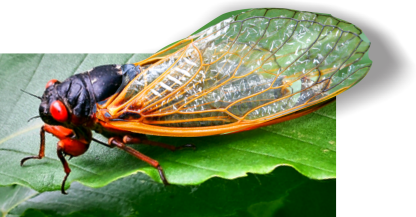June 11, I am ready for them to be “done” ha ha. wikipedia says cicadas began about 250 million years ago. 
observations:
if they fall on their backs they must expend an enormous amount of energy to right themselves and sometimes are unable.
if they fall into a puddle it means pretty certain death because their wing muscles are not sufficient to break the surface tension of the water. I have rescued many from the cat’s water bowl and from shallow puddles in the sidewalk.
they can fly a little, haha, but not much. Most i have seen a cicada fly is about 40 feet. If one grabs them by both wings to move them to the side of the walkway and sends them air born, most just make a deep dive to the ground. Presumably those are the cicadas that have performed their function and they have no energy reserves. (fun article on the science behind their wings)
i have seen them fly into stone walls and brick buildings. They must not have good vision, or visual processing capabilities.
Their legs are their strongest point, obviously for climbing up that tree. I did read that one website said they had 6 pairs of legs…. i tried to contact them to get them to edit it to 3 pairs (as insects have), but there was no good way to tell them. Anyone looking at the belly up of a dead cicada shows very large legs, redish, folded neatly across their abdomens (the latter with red stripes).
I wonder if the males do the flying mostly and the females just go straight to the tree branches without venturing out. The cicadas i toss into the air are mostly males as they chirp because of the disturbance.
i mowed grass today…. these bugs are big (thank goodness they are not the biggest cicadas (as noted below) but they are about 2.5 inches, its good they are not the loudest cicadas (as noted below) but the drone is still undeniable and kind of nice but after a long time (weeks and weeks) its a little annoying,
but they might be the dumbest… ha ha… per todays observation – any female cicada that thinks that my briggs and stratton lawn mower engine sounds like a handsome male cicada ready for mating is going to become a statistic of darwinian evolution…. survival of the fittest…. as they just fly into me, into the lawn mower and if they are down close to the wind tunnel created by the lawnmower blade they become new fertilizer for the grass… and thus dont propagate….
25 eggs (give or take) per slit, 300 eggs (give or take) per female – 12 slits per female
i have had so much fun thinking about these bugs, but ugg… ha ha… 4 more weeks and they are gone for another 17 years (well not gone, just underground preparing for their next emergence)
While these are interesting, loud, and sometimes annoying, i am grateful they are not the Emperor Cicada with a wingspan of 7 – 8 inches. YIKES. Or the Greengrocer cicada in australia which is touted as one of the loudest insects in the world. Imagin billions of those in the air.
from the ancient literature here is an ode to the cicada: “and the tuneful Tettix sitting on his tree in the weary summer season pours forth from under his wings his shrill song”
which i have converted into a kid’s rhyme….
“here’s to the cute cicada
clinging to a tree
who in the summer’s heat
chirps his melody”



